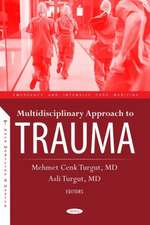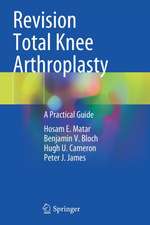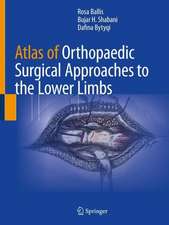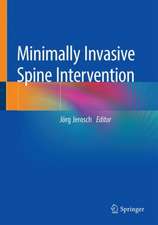Reverse Shoulder Arthroplasty: Current Techniques and Complications
Editat de Stefano Gumina, Federico Alberto Grassi, Paolo Paladinien Limba Engleză Hardback – 13 dec 2018
Reverse shoulder arthroplasty is becoming increasingly common because conventional total shoulder replacement may cause pain, loss of strength, simple or complex disabilities as well as limited motion, reducing general quality of life. The goal of a reverse prosthesis is to restore a painless, biomechanically valid joint. Drawing on the results of recent studies, the book covers all relevant aspects of RSA, including basic science, pathogenesis, clinical and instrumental evaluation, surgical techniques and complication management, helping readers to better understand when and how reverse shoulder arthroplasty should be implanted and what to do in cases of poor results. Written by leading shoulder specialists, the book provides surgeons and rehabilitation specialists, as well as residents and shoulder fellows, with a valuable, state-of-the-art guide for clinical practice.
Preț: 886.18 lei
Preț vechi: 932.82 lei
-5% Nou
Puncte Express: 1329
Preț estimativ în valută:
169.59€ • 176.68$ • 141.01£
169.59€ • 176.68$ • 141.01£
Carte tipărită la comandă
Livrare economică 06-12 februarie 25
Preluare comenzi: 021 569.72.76
Specificații
ISBN-13: 9783319977423
ISBN-10: 3319977423
Pagini: 471
Ilustrații: XV, 375 p. 252 illus., 164 illus. in color.
Dimensiuni: 178 x 254 mm
Greutate: 1.13 kg
Ediția:1st ed. 2019
Editura: Springer International Publishing
Colecția Springer
Locul publicării:Cham, Switzerland
ISBN-10: 3319977423
Pagini: 471
Ilustrații: XV, 375 p. 252 illus., 164 illus. in color.
Dimensiuni: 178 x 254 mm
Greutate: 1.13 kg
Ediția:1st ed. 2019
Editura: Springer International Publishing
Colecția Springer
Locul publicării:Cham, Switzerland
Cuprins
Section I - Basic Science: 1 History of reverse shoulder arthroplasty.- 2 Shoulder anatomy.- 3 Biomechanics.- 4 Epidemiology and demographics of reverse shoulder arthroplasty. Section II – Pathologies_Cuff tear arthropathy: 5 Etiopathogenesis.- 6 Classifications.-7 Natural history.- 8 Clinical evaluation. -9 Instrumental evaluation: Xray, ultrasound, MRI, CT, Arthro CT. Proximal Humeral fractures: 10 Introduction and Classifications.-11 Instrumental evaluation: Xray, CT.- 12 Fix or replace?.-13 Irreparable cuff tear.- 14 Gleno-humeral arthropathy in patients with healthy rotator cuff.- 15 Proximal humerus neoplasia: revision of the literature.- 16 Humeral head non-union. Section III- Surgical treatment: 17 Preoperative planning.- 18 Operating room setting.-19 Anesthesiological techniques.- 20 What do the companies propose?. Section IV - surgical technique: 21 Cuff tear arthropathy.- 22 Proximal humeral fracture.- 23 Lateralization of reverse total shoulder arthroplasty: when and how.- 24 Scapular notching: how to avoid it.- 25 Fractures sequaele.- 26 Proximal humerus neoplasia.- 27 Failed TSA.- 28 Reverse shoulder arthroplasty in patients younger than 55 years. Section V- Complications: 29 Complications in reverse shoulder arthroplasty: Focus on comorbidities.- 30 Management of periprosthetic reverse shoulder arthroplasty infections.- 31 Intraoperative fractures. 32 Failure of RSA. Section V-post surgery: 33 Postoperative rehabilitation.- 34 Outcomes of RSA: review of literature and personal experience.
Recenzii
“This book discusses the history of reverse shoulder arthroplasty and goes over anatomy, biomechanics, and indications for surgery. … This book is useful for readers wishing to learn about reverse total shoulder arthroplasty in a book format.” (Benjamin A Goldberg, Doody's Book Reviews, April 12, 2019)
Notă biografică
Stefano Gumina, MD, PhD, is Professor in Orthopedics and Traumatology at the Department of Anatomy, Histology, Legal Medicine and Orthopedics and Traumatology at the Sapienza University of Rome, Italy. Since 2008 he has worked as an orthopedic surgeon, specializing in shoulder surgery, at the same university. . In 2000 and 2001 he spent periods as a fellow at the University of Texas Health Science Center at San Antonio, the Cleveland Clinic Foundation, and the Rush Presbyterian-St Luke’s Hospital at Chicago. In 2003 he obtained his doctorate in Physiopathology of the Skeletal Apparatus, focusing his attention on shoulder disorders. Associate Member of the European Society for the Surgery of the Shoulder and Elbow (ESSSE/SECEC) since 1997, he was nominated as an Ordinary Member in 2001. In 2006 he was nominated as a Corresponding Member of the American Shoulder & Elbow Surgeons. His interest in shoulder disorders and surgery dates back to 1990 and is reflected by the publication of numerous papers in Italian and international journals. He is President of the Italian Society of Shoulder and Elbow Surgery (SICSeG).
Federico Alberto Grassi is Professor and Chairman of the Department of Orthopedics and Traumatology at the University of East Piedmont , Hospital “Maggiore della Carità” (Novara, Italy). He was educated at the University of Pavia (Italy), qualifying as a doctor in 1986 and specialist in Orthopedics in 1991. He then completed a Shoulder Fellowship at the University of Texas in San Antonio with Charles A. Rockwood (1991-92). Between 1992 and 2000 he served as Assistant Professor of Orthopedics and Traumatology at the University of Insubria (Varese, Italy), where he progressed to the position of Associate Professor (2001-2005) and Full Professor (2006-2008) under the direction of Paolo Cherubino. Prof. Grassi's clinical and surgical practice has always been dedicated to shoulder problems, with a special interest in artrhoplasty and trauma. He is author of several publications on different topics concerning the shoulder and editor of an Italian textbook of Orthopedics and Traumatology for medical students and junior residents. He served as President of the Italian Society of Shoulder and Elbow Surgery (SICSeG) during the 2015-16 biennium.
Paolo Paladini is chief of Unit of Shoulder and Elbow Surgery of Cervesi Hospital in Cattolica (RN, Italy). He was educated at the Catholic University of Rome (Italy), qualifying as a doctor in 1993 and specialist in Orthopedics in 1999 at Ancona University. During his residency he completed a Shoulder Fellowship at the Epsom General Hospital under Dr. D.H. Mok. (1995). In 2000 he founded, with Dr. Giuseppe Porcellini, a Unit of Shoulder and Elbow surgery at Villa Serena Private Clinic in Forlì (Italy). His clinical and surgical practice has always been dedicated to shoulder and elbow problems. Author of several international publications on different topics concerning the shoulder and elbow, Dr Paladini is involved with important international societies in the field: member of Italian Society of Orthopedics (SIOT), board member of Italian Society for Shoulder and Elbow Surgery (SICSeG), corresponding member of the American Shoulder and Elbow Society (ASES), ordinary member of European Society for Shoulder and Elbow Surgery (SECEC-ESSSE), and member of its East European Support Committee.
Federico Alberto Grassi is Professor and Chairman of the Department of Orthopedics and Traumatology at the University of East Piedmont , Hospital “Maggiore della Carità” (Novara, Italy). He was educated at the University of Pavia (Italy), qualifying as a doctor in 1986 and specialist in Orthopedics in 1991. He then completed a Shoulder Fellowship at the University of Texas in San Antonio with Charles A. Rockwood (1991-92). Between 1992 and 2000 he served as Assistant Professor of Orthopedics and Traumatology at the University of Insubria (Varese, Italy), where he progressed to the position of Associate Professor (2001-2005) and Full Professor (2006-2008) under the direction of Paolo Cherubino. Prof. Grassi's clinical and surgical practice has always been dedicated to shoulder problems, with a special interest in artrhoplasty and trauma. He is author of several publications on different topics concerning the shoulder and editor of an Italian textbook of Orthopedics and Traumatology for medical students and junior residents. He served as President of the Italian Society of Shoulder and Elbow Surgery (SICSeG) during the 2015-16 biennium.
Paolo Paladini is chief of Unit of Shoulder and Elbow Surgery of Cervesi Hospital in Cattolica (RN, Italy). He was educated at the Catholic University of Rome (Italy), qualifying as a doctor in 1993 and specialist in Orthopedics in 1999 at Ancona University. During his residency he completed a Shoulder Fellowship at the Epsom General Hospital under Dr. D.H. Mok. (1995). In 2000 he founded, with Dr. Giuseppe Porcellini, a Unit of Shoulder and Elbow surgery at Villa Serena Private Clinic in Forlì (Italy). His clinical and surgical practice has always been dedicated to shoulder and elbow problems. Author of several international publications on different topics concerning the shoulder and elbow, Dr Paladini is involved with important international societies in the field: member of Italian Society of Orthopedics (SIOT), board member of Italian Society for Shoulder and Elbow Surgery (SICSeG), corresponding member of the American Shoulder and Elbow Society (ASES), ordinary member of European Society for Shoulder and Elbow Surgery (SECEC-ESSSE), and member of its East European Support Committee.
Textul de pe ultima copertă
This handbook fully investigates reverse shoulder arthroplasty (RSA), presenting all the recent advances in the field to enable shoulder surgeons to treat patients with complex conditions, such as rotator cuff tears and instability, failed surgery and combined arthritis, or proximal humerus neoplasia.
Reverse shoulder arthroplasty is becoming increasingly common because conventional total shoulder replacement may cause pain, loss of strength, simple or complex disabilities as well as limited motion, reducing general quality of life. The goal of a reverse prosthesis is to restore a painless, biomechanically valid joint. Drawing on the results of recent studies, the book covers all relevant aspects of RSA, including basic science, pathogenesis, clinical and instrumental evaluation, surgical techniques and complication management, helping readers to better understand when and how reverse shoulder arthroplasty should be implanted and what to do in cases of poor results. Written by leading shoulder specialists, the book provides surgeons and rehabilitation specialists, as well as residents and shoulder fellows, with a valuable, state-of-the-art guide for clinical practice.
Reverse shoulder arthroplasty is becoming increasingly common because conventional total shoulder replacement may cause pain, loss of strength, simple or complex disabilities as well as limited motion, reducing general quality of life. The goal of a reverse prosthesis is to restore a painless, biomechanically valid joint. Drawing on the results of recent studies, the book covers all relevant aspects of RSA, including basic science, pathogenesis, clinical and instrumental evaluation, surgical techniques and complication management, helping readers to better understand when and how reverse shoulder arthroplasty should be implanted and what to do in cases of poor results. Written by leading shoulder specialists, the book provides surgeons and rehabilitation specialists, as well as residents and shoulder fellows, with a valuable, state-of-the-art guide for clinical practice.
Caracteristici
Provides a comprehensive, state-of-the-art overview of reverse shoulder arthroplasty Offers guidance on clinical evaluation, surgical techniques and complications Written by leading shoulder specialists Includes a wealth of surgical images



























